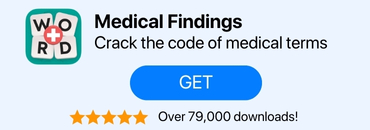You will be able to learn a variety of root words and combining forms associated with the nervous system as you go through this quiz.
Quick Review for the Quiz
Check out the flashcard version for a more detailed review.
| Word Root | Combining Form | Body Part or Condition |
|---|---|---|
| cephal | cephal/o | head |
| cerebell | cerebell/o | cerebellum |
| cerebr | cerebr/o | cerebrum |
| cortic | cortic /o | cerebral cortex |
| dur | dur/o | dura mater |
| encephal | encephal/o | brain |
| esthesi | esthesi/o | sensation |
| gangli, ganglion | gangli/o, ganglion/o | ganglion |
| gli | gli/o | neuroglia |
| medull | medull/o | medulla oblongata |
-
Question of
Find the combining form of the image highlighted.

-
cephal/o
-
head/o
-
encephal/o
-
rhiz/o
Correct Wrong
cephal/o is a combining form that refers to "head". The head is the upper part of the body, the part above the neck where the eyes, nose, mouth, ears, brain, and the skull with its contents and coverings are located. It is joined to the spinal column by way of the first cervical vertebra, the atlas. It is also connected to the trunk of the body by the muscles, blood vessels, and nerves that constitute the neck.
-
-
Question of
Find the combining form of the image pointed to.

-
cerebell/o
-
cerebr/o
-
esthesi/o
-
phas/o
Correct Wrong
cerebell/o is a combining form that refers to "cerebellum". The cerebellum ("little brain”) is a part of the brain situated at the back of the head, just above and behind the spinal cord. Cerebellum is an essential part of the brain that controls most physical movements and is mostly responsible for the control of muscles, including movement and balance. In addition, it helps to process language and memorize information.
-
-
Question of
Find the combining form of the image highlighted.

-
cerebr/o
-
cerebell/o
-
neur/o
-
poli/o
Correct Wrong
cerebr/o is a combining form that refers to "cerebrum". In the brain, the cerebrum is the biggest part. It consists of two halves, or hemispheres, called cerebral hemispheres. Cerebral areas control muscle function, speech, thought, emotions, reading, writing, and learning.
-
-
Question of
Find the combining form of the image pointed to.

-
cortic /o
-
cerebral/o
-
ment/o
-
gli/o
Correct Wrong
cortic /o is a combining form that refers to "cerebral cortex". Located on top of the cerebrum, the cerebral cortex is its outer layer. In the cerebral cortex, there are three types of functional areas: motor, sensory, and association areas. Sensory areas receive sensory information from the thalamic nuclei, while motor areas control motor activities.
-
-
Question of
Find the combining form of the image pointed to.

-
dur/o
-
matter/o
-
cerebell/o
-
cortic /o
Correct Wrong
dur/o is a combining form that refers to "dura mater". The dura mater is often called simply the dura. It is one of three layers of connective tissue that make up the meninges of the brain (pia, arachnoid, and dura). This layer surrounds and protects the brain and spinal cord, and it is the outermost of the three meninges.
-
-
Question of
Find the combining form of the image highlighted.

-
encephal/o
-
brain/o
-
phas/o
-
medull/o
Correct Wrong
encephal/o is a combining form that refers to "brain". The brain is one of the most sophisticated organs in our body. It controls every function in our body, including thought, emotions, touch, motor skills, vision, breathing, temperature, hunger, and more. There are more than 100 billion nerves in the brain that are connected by trillions of synapses. The brain and the spinal cord that branch from it form the central nervous system.
-
-
Question of
Find the combining form of the image highlighted.

-
esthesi/o
-
sensat/o
-
dur/o
-
thalam/o
Correct Wrong
esthesi/o is a combining form that refers to "sensation". A sensation is the detection of an incoming nerve impulse in a part of the brain called the sensorium. In other words, the perception of a stimulus as a result of its interpretation by the senses.
-
-
Question of
Find the combining form of the image pointed to.

-
gangli/o
-
gangl/o
-
narc /o
-
somn/o
Correct Wrong
gangli/o or ganglion/o is a combining form that refers to "ganglion". A ganglion consists of several neuronal bodies in the peripheral nervous system (PNS). A ganglia is a structure that serves as a relay station for synaptic transmission between neurons. Information enters the ganglia, triggers the firing of neurons within the ganglia, and is then released out of the ganglia.
-
-
Question of
Find the combining form of the image highlighted.

-
gli/o
-
neurogli/o
-
neur/i
-
ganglion/o
Correct Wrong
gli/o is a combining form that refers to "neuroglia". The neuroglia, also known as glial cells or glia are a variety of cells that provide neuronal development, physiological support, and metabolic support. In the nervous system, they maintain homeostasis and immunity. The neuroglia are the supporting cells. While neurons are the body's communication network, neuroglia facilitate its functioning.
-
-
Question of
Find the combining form of the image pointed to.

-
medull/o
-
oblongat/o
-
thalam/o
-
myel/o
Correct Wrong
medull/o is a combining form that refers to "medulla oblongata". In your brain, the medulla oblongata is located at the bottom. This is the place where your brain and spinal cord connect, serving as a key conduit for nerve signals. The medulla oblongata transmits signals from the spinal cord to the higher parts of the brain and controls autonomic functions, such as heartbeat and respiration.
-




